

attitudes about school and parents, peer-group influence, eating problems) new items added to address adolescent problems and behaviours (e.g. 704-item Form TX administered to 815 girls and 804 boys in normative sample, ages 14-18, as well as in an extensive clinical evaluation study Experimental “Form TX” for adolescents, to see if a separate version of the MMPI for adolescents would prove useful and valid

O Clinical problem areas (Family problems, Work interference, Negative treatment indicators) O Externalizing behaviour (Anger, Antisocial practices) O Personality factors (Type A behaviour, Cynicism)

O Symptomatic behaviour (Anxiety, Fears, Obsessiveness, Depression, Health concerns, Bizarre mentation) O MMPI-2: T score of 65 (92nd percentile) is the optimal score level for separating known clinical groups from the normative sample indicates “clinical range” O Original MMPI: consider T score of 70 a cutoff for “clinically significant” (95th percentile) O T-score distributions: mean of 50, standard deviation of 10 Original MMPI norms developed using a linear T-score transformation This is likely due to the change in test administration (originally item omissions were allowed, now they are discouraged) Present-day subjects tend to endorse more items in the pathological direction, producing higher mean scores. Studies were conducted with: inpatient psychiatric facilities, alcohol treatment settings, mothers at risk or child abuse, outpatients in marital distress, antisocial personalities, posttraumatic stress-disordered veterans, older men, military personnel, college students a number of normative and clinical studies provided validation for the MMPI-2 standard scales and the new content scales. balanced for gender and demographic characteristics (e.g. normative sample of 2,600 subjects (1,462 women & 1,138 men) To ensure continuity with the original instrument, keep the MMPI validity, standard, and several supplementary scales virtually intactĭevelop new scales to address problems not covered in the original MMPIĬollect new, randomly solicited samples of adults and adolescents, representative of the US population, to develop age-appropriate normsĭevelop new normative distributions that would better reflect clinical problemsĬollect a broad range of clinical data for evaluating changes to be made in the original scales and for validating the new scales MMPI Restandardization Committee’s goals:ĭelete objectionable, nonworking, outdated items, and replace with items addressing contemporary clinical problems and applications

1982, revision of MMPI was not to radically change it, but to modernize and restandardize an instrument of demonstrated reliability and validity original normative sample was white, rural subjects from Minnesota, while instrument was used across the US with broadly diverse clients items become out of date, some items were objectionable, “Blind/Dustbowl Empiricism”- Hathaway & McKinley’s strategy of classifying items with constructs based solely on comparing the responses of normal subjects with groups of well-classified patients (see pg. individuals with depression) from their normative sample (e.g. Empirical Scale-Construction strategy: any item on a scale was assigned to that scale only if it objectively discriminated a given criterion group (e.g. Individuals endorsing more symptoms of a particular kind are viewed as experiencing a more serious problem Patients who endorsed similar items/symptoms on the MMPI are diagnostically more alike than different Hathaway & McKinley believe self-report provides useful information Person’s score can be interpreted using norms Possible to evaluate the credibility of a person’s self report (using validity scales) Simple language, simple administration & scoringĬlinical familiarity of profile variables Useful predictive information in a cost-effective manner, Many research studies document its reliability/validity, Useful and practical technique for assessing individuals reporting mental health symptoms and problems, Used in many settings (psychiatric clinics, hospitals, medical settings, adolescents, inmates, alcohol/drug treatment units, military personnel, applicants for highly responsible positions)ġ940s-50s first translations by 1989 there were over 140 MMPI translations in 46 countries MMPI has become the most widely used and researched objective personality inventory in the world Research began in 1939 (Hathaway & McKinley) to develop an inventory to aid in assessing and diagnosing patients with mental disorders Objective Personality Assessment using the MMPI-2 and MMPI-A


 0 kommentar(er)
0 kommentar(er)
